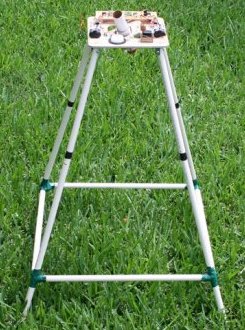Gyro-controlled Rocket
I built a gyro-controlled rocket using an SX18 and a 2 dimensional rate gyro from SparkFun.· The rocket is named Quad Pod II, and it uses a gimballed motor mount instead of fins to control the direction of flight.· It is intended to fly at a low speed and altitude.
I've had successful flights on Estes E9 and Apogee F10 motors.· Videos of two of the flights are at
http://www.youtube.com/watch?v=XiVpxxK_PxA·and
http://www.youtube.com/watch?v=wQk2z1nT3cU
I have more information on the rocket at
http://home.swbell.net/davehein/ModX/quadpod_ii.html
A picture of the rocket, a schematic and the source code are attached below.
Dave
I've had successful flights on Estes E9 and Apogee F10 motors.· Videos of two of the flights are at
http://www.youtube.com/watch?v=XiVpxxK_PxA·and
http://www.youtube.com/watch?v=wQk2z1nT3cU
I have more information on the rocket at
http://home.swbell.net/davehein/ModX/quadpod_ii.html
A picture of the rocket, a schematic and the source code are attached below.
Dave






Comments
▔▔▔▔▔▔▔▔▔▔▔▔▔▔▔▔▔▔▔▔▔▔▔▔
When the going gets weird, the weird turn pro. -- HST
1uffakind.com/robots/povBitMapBuilder.php
1uffakind.com/robots/resistorLadder.php
http://www.youtube.com/watch?v=AkwYps7gdZQ·.
The webpage for the original Quad Pod is at http://home.swbell.net/davehein/ModX/quadpod.html·.
Dave
▔▔▔▔▔▔▔▔▔▔▔▔▔▔▔▔▔▔▔▔▔▔▔▔
When the going gets weird, the weird turn pro. -- HST
1uffakind.com/robots/povBitMapBuilder.php
1uffakind.com/robots/resistorLadder.php
▔▔▔▔▔▔▔▔▔▔▔▔▔▔▔▔▔▔▔▔▔▔▔▔
Thank's Brian
·"Imagination is more important than knowledge..." ·· Albert Einstein
www.PropelX.com
Dave
I see that Armadillo Areospace is getting $500K for their test lander, you could get big money for the Qaud Pod.
▔▔▔▔▔▔▔▔▔▔▔▔▔▔▔▔▔▔▔▔▔▔▔▔
Thank's Brian
·"Imagination is more important than knowledge..." ·· Albert Einstein
www.PropelX.com
Next May, over Memorial Day weekend, WOOSH (NAR #558) will host the National Sport Launch at Bong Recreation Area in southern Wisconsin. Any chance you could make plans to come, and fly that thing for us there?
Dave
I was watching Armadillo Aerospace videos recently. I see your rocket is ~sort of~ similar. When I was watching the AA videos I trying to think how I could build something smaller to test a gimbal motor mount. It looks like you have done what I was only starting to wonder about. Neat project, very neat.
Question:· Why a gyro and not an accelerometer?· With an accelerometer couldn't you still calculate the vertival access and position the servos?
▔▔▔▔▔▔▔▔▔▔▔▔▔▔▔▔▔▔▔▔▔▔▔▔
Timothy D. Swieter, E.I.
www.brilldea.com·- Prop Blade, LED Painter, RGB LEDs, uOLED-IOC, eProto fo SunSPOT, BitScope
www.sxmicro.com - a blog·exploring the SX micro
www.tdswieter.com
Post Edited (Timothy D. Swieter) : 8/16/2008 2:48:47 PM GMT
If you know that you will only accelerate or tilt, it can work great; But rockets have both acceleration and tilt.
▔▔▔▔▔▔▔▔▔▔▔▔▔▔▔▔▔▔▔▔▔▔▔▔
The pessimist is never disappointed.
Dave
▔▔▔▔▔▔▔▔▔▔▔▔▔▔▔▔▔▔▔▔▔▔▔▔
--Steve
You can power the SX-18 from 3.3 volts and remove one of the regulators from the project. Since you're using linear regulators, they're wasting power in the form of heat. The only catch is you'll need to use the new USB SX-Key to program the SX-18 at the lower voltage. The USB SX-Key is powered from the USB port, not the project.
Thanks,
PeterM
I really like this project. Very well done.
PJMonty's idea could mean you could use a smaller lighter battery also, but I don't think you're fighting a weight problem.
Again, well done. When you start making a jet pack, let me know.
Chris
I have run an SX18 at 3.3 volts in a previous project.· This was a camera controller that strobed the shutter switch on an Aiptek camera.· The camera ran at 3.3 volts internally, so I tapped off the power from the camera to run the SX18.· I have a serial SX key, so I had to use the device that Parallax sold to isolate the power from the SX key.· I think its call a key ring, but I may be wrong about the name.· This works OK.· However, the USB key sounds like a better solution.
I do plan to build a more conventional rocket in the future that would fly to 500 feet or so.· I can easily trim down the gimballed motor mount to fit into a 5.5 inch body tube.· The batteries and controller board would be moved up toward the nose cone, and I would run two cables down to the servos.· The goal would be to get the weight down as low as possible, so I would probably go with a single battery.· I might use switching regulators to extend the battery life.
Dave